Wood sometimes has unwanted natural staining or its natural colour is too dark to achieve a very light, almost white finish. Also, during drying, mechanical processing or white preparation, certain stains or discolourations may appear which must be removed without affecting the natural colour of the wood. In the first case it is necessary to bleach the wood, while in the second case it will be discoloured.
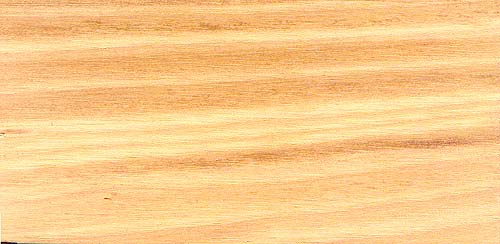
photo source: hoovedesigns.com
Bleaching and bleaching are actually two different operations, but in factories the term bleaching is used for both. Fading is done when stains appear on wood due to contact with metals, staining solutions or adhesives. In this case, less aggressive solutions are used, which remove stains but do not change the natural colour of the wood.
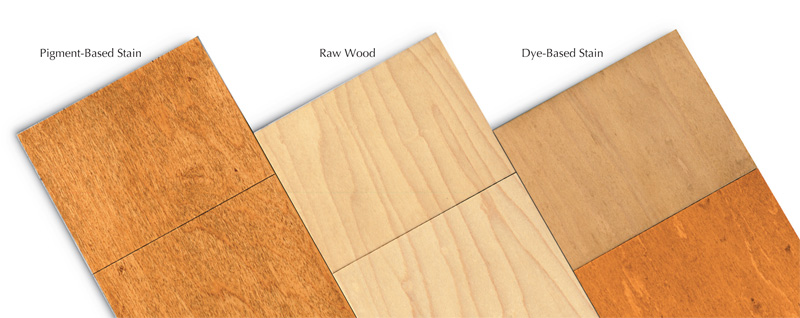
sirsa photo: popularwoodworking.com
The solutions used for bleaching can be mixtures of diluents or weak solutions of acids or bases which do not require special precautions, as they are substances often used in the household. However, even in this case care must be taken and hands and eyes must be protected.
To remove colour stains from wood, the following can be used sodium hypochlorite, i.e. the usual laundry bleach, the one containing chlorine. It attacks berries, solvent-soluble colours, but does not change the colour of the wood, nor does it attack pigment-based colours (those insoluble in solvents, which form dispersions). This is the case for paints or outdoor colours. It is used diluted with water, the dilution depending on the bleach concentration. Apply with a brush or sponge and wash the wood with water afterwards. Sometimes, for more effective removal, washing is combined with white sanding.

photo source: treelayers.ro
Sodium hypochlorite can also be used when the wood has been slightly touched by mould. Be careful, this is not the case for wood that has been attacked from the tree stage, or fallen trees. This type of mould is very difficult to remove, sometimes even impossible, and greatly diminishes the qualities of the wood. Hypochlorite does not act on blue mould that appears during the drying of timber or on mould that has been left outside for a while unprotected (decks, patios, fences). Blue mould can also be cleaned with a concentrated 35% solution of perhydrol (hydrogen peroxide).
Surface black stains caused by contact of tannin wood with metal can be removed by washing with weak solutions of organic acids. Use citric acid - lemon salt, or oxalic acid. Both are available to buy in solid, white crystal form. Dissolve them in warm water and wash the surface with the resulting solution. Finally the wood is washed with water. Be careful, oxalic acid is an irritating substance, you must wear gloves and glasses when doing the bleaching. Care should also be taken when sanding afterwards, as acid crystals may remain in the wood.
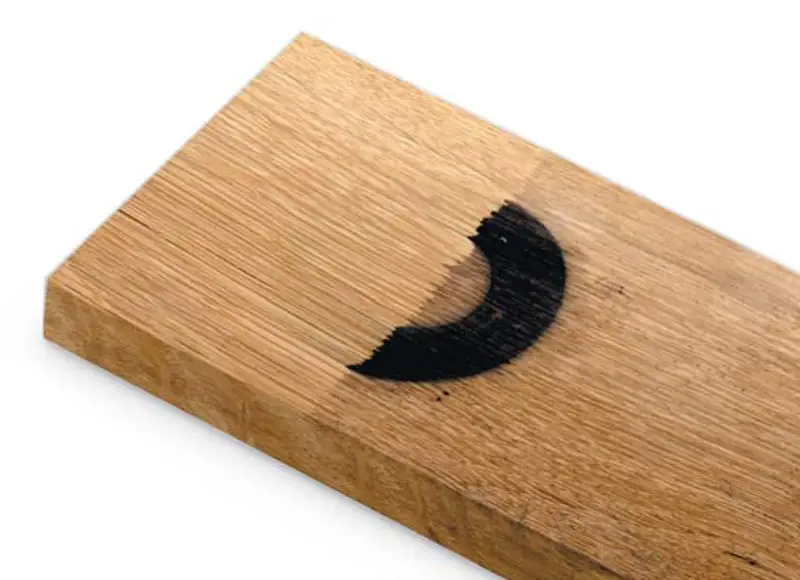
photo source: popularwoodworking.com
Resin stains, in the case of softwood, or adhesives can be removed by brushing with hot weak alkaline solutions (ammonium bicarbonate - food grade ammonia), then neutralize the surface with 5% acetic acid (vinegar). Resin stains can also be removed by washing with organic solvents.
Wood bleaching is the process of attacking the colouring substances in the wood structure, partially destroying them. The natural colour of the wood is partially or completely changed by the bleaching process, and the wood becomes lighter. The species most often subjected to this operation are beech, cherry, oak and walnut.

photo source: popularwoodworking
Bleaching is also sometimes used for artistic purposes. For example, venge wood is a mixture of light and dark brown and black. Bleaching only attacks the light brown fibre which changes colour to grey. The bowls made from venge wood that have undergone bleaching are very beautiful, reminiscent of African art.
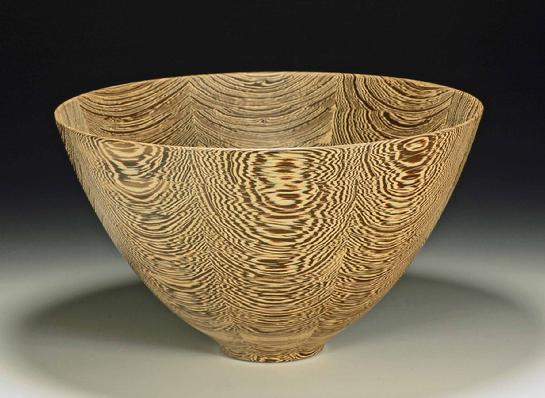
photo source: crestcreation.net
The most widely used variant for bleaching wood is the mixture of caustic soda (sodium hydroxide) and hydrogen peroxide (perhydrol). Substances are sold separately and mixing is done at the time of bleaching. Bleaching can also be done by applying the substances one on top of the other. Always read the directions for use on the labels. Once the reaction is complete, if the proportions are respected, there is no need to wash the wood because the substances neutralise each other and turn into water and carbon dioxide.
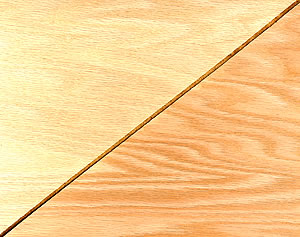
photo source: paintpro.net
Both substances can also be used separately. In the case of soda, great care must be taken because it is very corrosive. After application, the wood must be washed thoroughly.
A treatment withperhydrol and an ammonia solution. Both are volatile substances that leave no residue after use. Being corrosive at the same time, they should be used with great care, protecting hands and eyes.
The desired result is very rarely achieved in a single step, sometimes requiring several successive treatments of the wood. There are species for which bleaching is done until the wood is practically white. This cannot be achieved with chemicals alone, but requires a combination of chemical treatment and the use of white pigmented paste. This is the method used to bleach maple, birch and poplar.
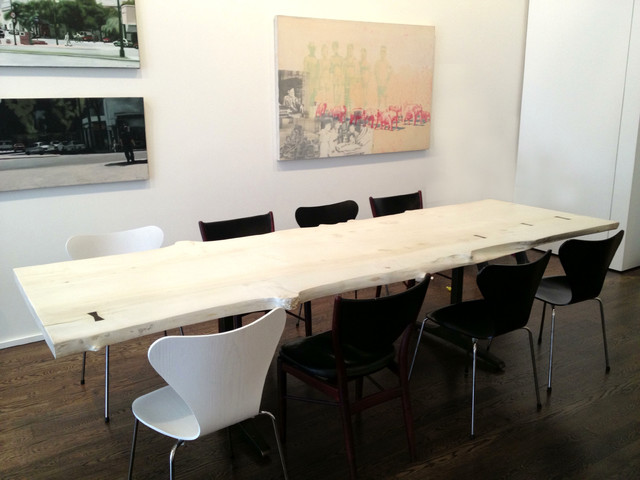
photo source: houzz.com
After bleaching, the wood should be left for 48 hours before finishing so that all volatile substances disappear and the water from the wash evaporates. Although it is believed that no residue remains, there are finishing products that are influenced by the products used for bleaching. This is the case for polyurethane varnish catalysts, which yellow very visibly on contact with these products. It is therefore not recommended that chemically bleached wood be finished with polyurethane products. Acrylic products are recommended, which not only do not change colour but also leave the wood unchanged. the natural look of the wood.
No matter how you bleach or bleach the wood, you should be aware that the substances used are aggressive and can harm you. You should wear protective equipment, protect your hands and eyes and it wouldn't hurt to wear a mask to avoid inhaling the fumes. Otherwise, good luck!
More about bleaching and discoloration of wood after removal of the old finishor about when discoloration and bleaching of wood is required.
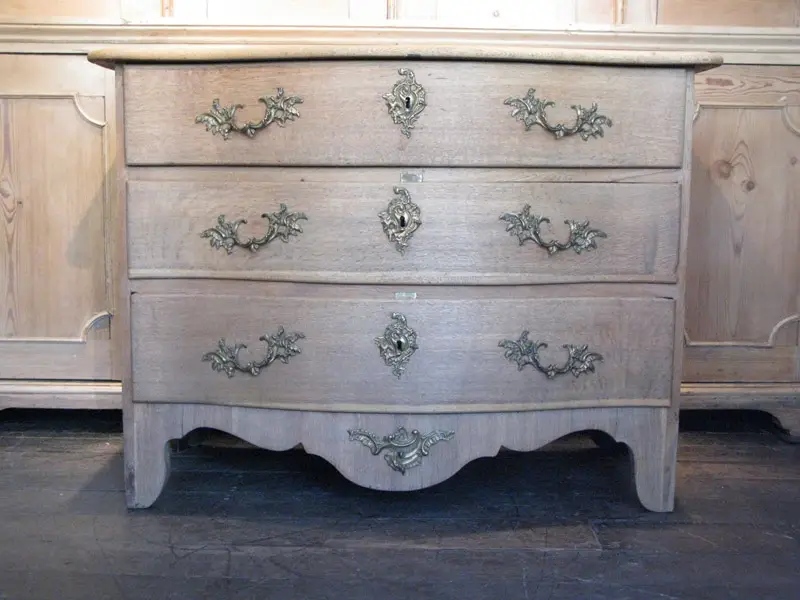
photo source: brownrigg.interiors.co.uk


























HELLO, I WOULD LIKE TO ASK YOU A QUESTION: HOW TO CLEAN A YELLOWED FILM, I MEAN THE KITCHEN FURNITURE THAT IS FINISHED WITH NITROCELLULOSE VARNISH. THANK YOU.
Good evening.
Unfortunately lakes also "age" over time. They turn yellow and this is most noticeable in nitrocellulose lakes. The process is irreversible, so the safe solution is to remove the existing varnish and apply another layer of varnish. Removing nitrocellulose varnish is not difficult. It can simply be washed off with thinner. If you are unable to take it to a factory for varnish removal, you can also do it at home with paint stripper bought from DIY stores. Apply the varnish with a brush, leave it for a while, then remove it with a scraper. Then sand the wood and apply 2-3 coats of varnish. Acrylic varnish is the most resistant to yellowing.
Good luck!
Hello, we have 90m2 of solid wood flooring. In the first phase it was light coloured and then we applied dark bait and varnish.
Is there any chance of returning to the original colour?
Will his defoliation affect the fault?
Or did the bath penetrate the wood structure? How can we initiate the colour opening process?
Good evening.
You should scrape it to remove both the lake and the bath. Being new flooring you should have no problems. The grout has penetrated the wood, but scraping removes a thin layer of wood, therefore removing the grout as well.
After sanding, replace the sandpaper with a thinner one, sand and apply the new bait and varnish or just varnish.
Unfortunately you don't have another way to open the color.
All the best!
Hello,
Can you recommend a restorer for antique furniture (12 pieces)?
Good evening!
I sent you an email.
All the best!
Good evening. I have a couple of windows that are blackened by time. How could I restore them, even just the fart, to their natural wood color? Thank you
Hello.
From what you are saying I can't tell if it is the appearance of blackness on the windows or the darkening of the windows.
If it's blackness then it's mould. It should be wiped well with a dry cloth and then with one soaked in cheap bleach. It is based on sodium hypochlorite, a mould enemy. It should remove that black colour and protect the wood for a while.
If it is the wood darkening, it means that the varnish used had no UV protection and the wood components have decomposed darkening the colour. You should sand to remove the finish and the layer of darkened wood. Under this layer the wood has its normal colour. Then use for finishing products containing a small amount of pigment (lacquers) or UV absorbers (exterior varnishes) that protect the wood.
All the best!
Don't forget to subscribe to the printed Wood Magazine! For only 58 lei/year you can find out news in the field, discover craft ideas or trade secrets. We remind you that the content in the printed magazine is different from the one on the website. Details in the link below.
Thank you!https://revistadinlemn.ro/product/abonament-revista-din-lemn/
Hello. We recently built our house and unfortunately the interior oak stairs have suffered. They have yellowed and there are marks left from the workers gluing stuff on them in order to protect them. By the time they were stripped off there was trace left, probably also from the windows and the sun. How can we make them have the original colour and shape? If you give me an email address I can send you the picture. Thank you!
Hello.
Wood changes colour in contact with oxygen in the air and UV radiation. The change starts immediately after cutting. And the lake changes colour over time, it ages, as we say. It's all the ozone and the sun or bright light that's to blame.
more than likely the colour has changed in areas where it has not been protected from the sun. Now that the other areas have been uncovered the color will unoform over time. The easiest thing to do is to wait for this to happen because otherwise you have to remove the finish and sand the wood to remove the top layer that is affected. After that you can refinish. If you apply a coloured varnish on top to even it out it will not look nice and you will not achieve evenness unless the colour is very dark.
You can send your photo to mihaela.radu@cesbrands.ro.
All the best!
Don't forget to subscribe to the printed Wood Magazine! For only 58 lei/year you can find out news in the field, discover craft ideas or trade secrets. We remind you that the content in the printed magazine is different from the one on the website. Details in the link below.
Thank you!https://revistadinlemn.ro/product/abonament-revista-din-lemn/
Hello,
I have a big problem with interior doors. Unfortunately, I made some bad choices. I wanted the steps and doors in the house as dark as possible (almost black). The problem is that I don't know what products to use to clean the doors so that there are no marks left on them. Can you give me some advice, please? Thanks
Good evening!
It's kind of hard, especially if they have gloss. Try applying a thin layer of colourless furniture wax on top. Apply simply with a rag. You just have to spread it very well. Waxed surfaces are easier to maintain.
All the best!
Don't forget to subscribe to the printed Wood Magazine! For only 58 lei/year you can find out news in the field, discover craft ideas or trade secrets. We remind you that the content in the printed magazine is different from the one on the website. Details in the link below.
Thank you!
https://revistadinlemn.ro/product/abonament-revista-din-lemn/
Good evening,
I want to scrape the hardwood floors in my son's room.
My question is if after refinishing can a bait or primer be applied to change the colour of the floor to a light grey (this is what my boy wants).
Only then apply the varnish.
Now the floor is brown and I don't think it has ever been scraped (old manor house).
Thank you in advance
Good evening!
Yes, you can bathe the wood after you scrape the floor. The scraping should be done in such a way that the old colour is removed. I recommend the use of a trowel for the application of the wood stain. Allow to dry before applying varnish. Then apply min 2 coats of floor varnish.
All the best!
Good evening,
I purchased 2 pieces of walnut lumber and they have some stains on them. I read the article but can't figure out if it's the traditional mold or the blue mold. Can I possibly send you some pictures to help me with this information? After the wood is cleaned with chlorine or hydrogen peroxide is there still a possibility that the mould will reappear if the wood is kept in a dry environment? In case of blue mold is 35% hydrogen peroxide and 65% water added? How long should this solution stay on the wood? Afterwards, do you just clean it with water or do you have to sand it?
Thank you,
Andrei Veres
Good evening!
The blue mould is seen as a stain that is part of the wood fibre. It is not uniform, it can appear as if an annual ring is coloured. Regular mould is dark grey or black and no longer creates the impression that it is part of the wood but looks more like a stain. Regular mould is easier to get rid of than blue mould. When a wood is attacked by blue mould, changes in the wood's properties also occur, the changes are more profound, not just in colour. Blue mould is a wood disease.
If the wood is well cleaned, dry, kept in a place without moisture and where there are draughts, black mould will not appear. Mould appears on wood as it does on the wall - if there is a source of moisture and no draught to allow it to dry.
For blue mould you should try more aggressive solutions: caustic soda:pehidrol 2:1 (this is the classic A+B solution of commercially available wood bleach) or perhydrol and ammonia (solution 35%). Perhydrol and ammonia are not mixed but applied with a brush on top of each other. Apply hydrogen peroxide first, in excess, then apply the ammonia. After 2 hours wash off with plenty of water and allow to dry.
The combinations of substances used neutralize each other and it is enough to wash with plenty of water to remove the resulting salts and let dry. If you use basic solutions (caustic soda) neutralize with weak acids (vinegar). Afterwards wash with plenty of water. There is no need to sand after bleaching with chemicals.
You can send me photos to my email address mihaela.radu@cesbrands.ro
All the best!
Hello! I have a white wooden table and a little girl has stained it with spirt and the shape of the tablecloth has printed, what can I use to remove it? Thank you
Hello!
Try to tread on the surface. Place a piece of kneaded material on the surface and run a hot iron over it a few times. Pick up the material and let it cool. Check the area and if the situation seems to have improved, repeat the operation until the signs disappear.
If it doesn't work with the iron, it means the area is more seriously affected. You should sand with 280 or 320 grit sandpaper or a fine abrasive sponge until the defect disappears. Afterwards polish the entire surface with a white furniture wax cloth. If the defect is deep and you have reached the wood or in the area where the sanding was done there is a visible hole, you will have to sand the entire table top and apply a coat of white nitrocellulose or water-based paint.
All the best!
Hello
A few years ago I scraped the floor and then applied 3 coats of Palux.
Not long after (approx. 2 years) he was submerged.
From the article I understand it is black mold.
Please advise me what to do to remove the mould, apply a treatment to increase the resistance of the wood to water and mould, what finish to apply (please indicate which one).
Thank you.
Good evening!
There must have been cracks in the varnish film or the wood had pulled water from somewhere and mold had formed.
Against mould you can find effective products at Bochemit.
In order not to continually repair where black spots appear, you will need to scrape the entire package, treat it with Bochemit's solution against mold and mildew, and after drying, apply 2-3 coats of floor varnish.
You should check that there is no source of condensation or dampness under the floor. Seek the advice of a flooring specialist (other than the first one) to see if it has been fitted correctly.
All the best!